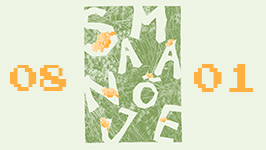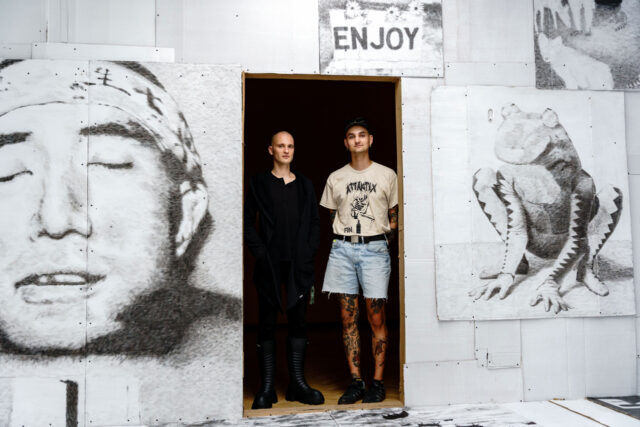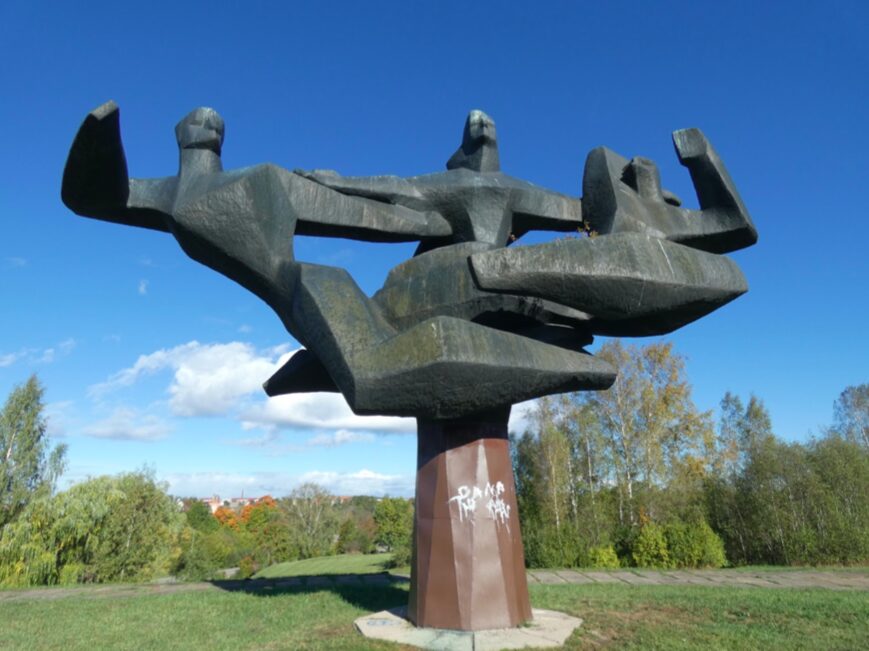Mateusz Choróbski pays a lot of attention to the exhibition space: his choice of architecture complements the artworks; and vice versa, the works help the environment in which they are exhibited to resonate. He has recently been focusing not only on developing visual ideas, but also on social themes. In this exhibition, he combines sculptural light objects with sensitive topics that are relevant both in Poland, his homeland, and in Lithuania. Here we talk with the artist about his ideas, his work, and his current exhibition in Vilnius.
Uršulė Baltėnaitė: You explain the concept of the exhibition’s name ‘For Whose Good’ with Cicero’s phrase ‘Cui bono?’, used in forensic science to assess who might have benefitted from a crime. What made you approach the social representation of Poland and Lithuania in the exhibition from this point of view? Have you thought about the answer to your own question, for whose good? And would your answer be valid for the situation both in Poland and in Lithuania?
Mateusz Choróbski: Seeking answers is not the point. Cicero’s statement from centuries ago and his ‘Cui bono’ question are still relevant. And so the mechanisms which this exhibition is dealing with, such as the transfer of goods and benefits, and the process of exclusion and alienation, are all present in our societies. In most cases, someone benefits from someone else’s loss. It doesn’t matter whether that is in Poland, Lithuania, or any other country. The title of the exhibition, with the question mark deliberately left out, implies that the question has been raised again and again, and yet multiple attempts to answer it have failed to bring about the expected change. We keep grappling with the same issue. Hence ‘For Whose Good’ is closer to a statement than a question. Likewise, it implies an unfortunate acceptance of reality as it is, rather than looking for answers and waiting for change.

Mateusz Choróbski. For Whose Good. 2023. Exhibition view. Photography: (AV17) Gallery
Uršulė Baltėnaitė: The exhibition ‘For Whose Good’ creates a misleading first impression: a cosy homey atmosphere, dim and warm light, the floor shining with copper. But the underlying idea is actually at a deeper level of the home theme: the poverty line. How did the idea for this visual expression come about? What does this (fake) home cosiness represent?
Mateusz Choróbski: The exhibition is conceived as a coherent statement, in which individual objects affect the whole, their meanings intersecting and complementing each other similar to the warm light emanating from the illuminated objects, the only source of light in the gallery, which fills the space with a Baroque yellow. At first glance, the construction-exhibition is designed to tantalise, entice, and lure the viewer in like a decoy. But it’s all just appearances. Beneath all the shine of coins and golden lighting, which creates a cosy atmosphere and ensures the well-being of the viewer, lies something antithetical to these sensations, namely exclusion, poverty, and the powerlessness of those who aren’t represented in art. This seduction mechanism has a meaning, because it’s a sort of universal indicator of the everyday reality, surface-level posturing and accruing one’s symbolic and financial capital at other people’s expense. After all, it is not just the art world that is built on smoke and mirrors.

Mateusz Choróbski. For Whose Good. 2023. Exhibition view. Photography: (AV17) Gallery
Uršulė Baltėnaitė: Conceptually, you combine different ideas, poverty with capitalism, cosiness with instability, rough industrial materials with the pleasant light that emanates from them. In the same way, the viewer, who initially admires the works, is introduced to their unexpected context. What emotions are you really trying to create?
Mateusz Choróbski: I’m not trying to create emotions. My intention in dealing with such subjects as in the case of ‘For Whose Good’ is by no means to define or formulate a close-ended narrative. I try to steer clear of pontification, or any didactic or categorical representation, so that what’s heavy, emotional and uncomfortable doesn’t morph into some kind of spectacle of poverty and an ostentatious display of a whole gamut of extreme emotions. In other words, it’s important to me that my work touches on the cause, not the effect. The causes might be more complex, ambiguous and contradictory, whereas the effects lend themselves to depiction, reduction and ultimate commodification.
I see there the potential for non-representational art that doesn’t utilise any pre-existing images, but creates a space for their singular emergence and uniquely personal experience. Some experiences and notions cannot be translated into figurative art.
Furthermore, this kind of exhibition concept offers the viewer not one, but many clues, which they might follow: the decision as to which path they want to choose is entirely up to them. To a large extent, it is the viewer who is responsible for interpreting and interacting with the exhibit. It depends on the experience they bring with them.
Uršulė Baltėnaitė: The sculptures in the exhibition are created from ready-made materials, which are supplemented by your casts. Do you have a specific way of selecting the objects you reuse for your artworks? Do they all have their own story, their meaning?
Mateusz Choróbski: The pieces you’ve just mentioned aren’t made from materials that are yet to be instilled with meaning. I prefer working with objects which already contain a morsel of content that can be modified and juggled visually and semantically, just as in poetry, at times combining things that are seemingly incongruous, so that the meaning of a work of art emerges at the initial stage of the selection of materials. This process begins first and foremost with a selection of their potential content, which can be discerned within and highlighted. The visual aspect is far from meaningless, but what first comes to mind is the consideration of what this thing is, what it was, and what it could signify. For this reason, these are often objects that have already fulfilled their primary function. They are discarded and dismissed for years to come, like radiators with multiple layers of paint, traces of the repeatedly painted rooms they once heated, door frames torn from homes, suction cups acquired at flea markets, or coins taken out of circulation.

Mateusz Choróbski. For Whose Good. 2023. Exhibition view. Photography: (AV17) Gallery
Uršulė Baltėnaitė: Your sculpture-light objects contain a contradiction: a warm light emanates from rough, industrial materials. How did this unexpected idea develop, to associate this light with such an influential theme, using a misleading cosy atmosphere to then represent instability and exclusion?
Mateusz Choróbski: The light itself doesn’t represent exclusion, it allows it to reveal itself. Although it creates this seemingly cosy atmosphere, the lack of it would result in deeply pessimistic connotations. In fact, alienation is not represented by the light, but by the used object and its history, like scrap metal in the form of radiators, or small change, that is, the smallest denomination, which we don’t even bother picking up on the street, and yet throw into the can of a person in need. Therefore, instability and exclusion are represented by the way we perceive something that we no longer need and notice. In my practice, I use these objects, the formerly used things I find, alongside their provenance and an awareness of their original function.
At the risk of sounding pompous, light can be associated with hope (which is an established link in art history). Not only does it create an apparent image of a pleasant experience of space, but creating these appearances might also offer a rare way to cope with one’s emotions and predicament for a person living on the edge of poverty. Perhaps the use of light would allow us (the viewers) to come to terms with something that is sometimes too hard to bear on a daily basis.
Uršulė Baltėnaitė: You have recently been concentrating on social and political themes in your work. What sparked your interest? What motivated you to create and draw the attention of the audience to these topics? What emotions do you experience when you create in a socio-political context, but at the same time are aware of the incredible scale of capitalism in the art market? Does this become a daily frustration, or is it an inspiration to speak out even louder on sensitive topics?
Mateusz Choróbski: Themes revolving around social issues have perhaps always been close to me, although at times unconsciously. As a student, I witnessed my father’s company going bankrupt after the financial crisis of 2008, and my father himself turning from a resourceful man into a completely lost and helpless person without a job. Barely a month after graduating, I moved from Warsaw to the USA. After a couple of weeks, I started working at this baseball cap factory in the New York fashion district. On entering a high-rise glass building, I was greeted by a doorman, walked to the lift on a red carpet, and as its doors opened on one of the floors, the sweatshop appeared right in front of my eyes. A ‘beautiful’ contradiction. I was the only white person working there illegally. Most of the staff consisted of immigrants from Latin America. The company was managed by two middle-class white men. I would have a one-dollar slice of pizza and a coffee for lunch. Sometimes I satisfied my hunger with just a coffee and cigarettes. What I can recall clearly from that period of my life is a feeling of powerlessness, my willingness to work and my inability to find employment. And a simultaneous awareness of my own insignificance. I could vanish in that city, and no one would even care. Perhaps that is the reason why I tend to avoid flaunting extreme emotions in my work. It seems to me that a person who has never faced any anxiety about their material situation wouldn’t be able to truly comprehend it. Empathy is not enough. Viewers of my exhibitions interact with them in two ways: in terms of an aesthetic, and with their own experience and preconceptions about/on the subject of poverty.
Although it’s hard to admit, I do sometimes feel this frustration, which can also be motivating. At the same time, I’m part of the art market. However, what is more interesting to me is the fact that art rarely even addresses the subject of poverty. I wonder if it simply stems from the notion that poverty is not cool. Perhaps it’s easier to ruminate on issues of marginalised or persecuted groups that still use the same language as us, and so belong to our ‘bubble’; whereas poverty is often associated with those with whom we don’t wish to be associated, with working, patriarchal, small-town or rural communities. It’s a bit like how Didier Eribon wrote in Returning to Reims. Even if we’ve managed to leave that kind of circle behind, we still feel this odd sense of class shame. So why even come back to it? Why deal with this at all? Moreover, it is the feeling of being pulled in two different directions. On one hand, you still feel like a member of this community, you feel drawn to it, and yet alien. On the other hand, you already belong to the class you aspire to, in which you have an unwavering sense that you need to prove your worth and value, and you’re still kind of incompatible.

Mateusz Choróbski. For Whose Good. 2023. Exhibition view. Photography: (AV17) Gallery

Mateusz Choróbski. For Whose Good. 2023. Exhibition view. Photography: (AV17) Gallery
Uršulė Baltėnaitė: How have social and political themes influenced your other ideas, materials and techniques over time? Do you ever create without thinking about the context behind the artwork?
Mateusz Choróbski: I don’t create art for the sake of art, neither materials. I think it is not possible to create with no context. Even unintentionally, the context appears on its own because we’re part of a bigger story. By creating, we make a public statement, which belongs to a wider discussion. We don’t live in a vacuum.
I also never select political themes at random, just pulling from the readily available stack of current issues. They originate from, or touch on, my personal experience. They’re part of my reality, as well as the reality of many other people who I know very well or just a little. The first piece made of coins seems worth mentioning here. In 2018, I exhibited Cream, an object made of melted one-penny coins with a collective value corresponding to the sum of my debts when the work was produced. The object was split in half and sold in two parts, each for the same amount as that of my debts. Despite the fact that one of them was sold, my debt was not cleared. The gallery snatched a 50% fee from the total sum, thus remaining the sole beneficiary of the transaction. I was still in the red. Ever since then, I’ve been observing my surroundings more closely. After all, every single one of us is saddled with some kind of ‘debt’, be it more of less substantial. That’s how I arrived at the themes that captivate me right now: questions about the dignity of life, living conditions, what provides us with a sense of security, and when our lives are in danger. It’s not politics, it’s the basis of our existence, regardless of time and place. Unfortunately, these questions resonate more strongly in the current post-pandemic state of affairs and with inflation raging all over the world. So the issue of the minimum subsistence level appears in my work.
Uršulė Baltėnaitė: Your exhibitions are presented in different countries. You adapt the works and ideas to the spaces in which they are exhibited. How do you choose these spaces: do they tell their own stories, is their (historical) context important, or are they chosen just to visually complement your ideas? Maybe it is the other way around: does the location dictate to you an idea for the work? How does this process of selecting spaces work?
Mateusz Choróbski: Although I would love to choose the places on my own, for the time being I receive invitations for exhibitions, like the former Le Scalze Church in Naples, the perfume museum of Palazzo Mocenigo in Venice, Villa Medici, the French Academy in Rome, and the SALTS garden in Basel. I create brand-new pieces for each exhibition, so that they are rooted in a specific place, engage in a dialogue with it, and at the same time tell/herald/signal the subjects that I find interesting and universal. Working on shows in these types of locations can be time-consuming, but it also offers an opportunity for learning more about local contexts, history and architecture. I often get a lot of satisfaction from consulting source materials, poring over some books and albums. With each subsequent piece, I want to gain a sense of overcoming my own habits, or, to put it simply, growth. As far as ‘For Whose Good’ is concerned, I also delve deeper into the subjects that fascinate me, notions relating to the human condition, in a new context (of a place or country) that organically broadens the potential for interpretation and experience of those works. Or should I say ‘co-experience’, since I never offer a single template for their understanding, which also brings me to the fact that I view my work in terms of visual poetry.

Mateusz Choróbski. For Whose Good. 2023. Exhibition view. Photography: (AV17) Gallery
Uršulė Baltėnaitė: Your works are usually exhibited in characteristic locations where a specific dialogue emerges with your site-specific sculptures. This exhibition, in the (AV17) gallery, is working more or less in a white cube. Was it more difficult or more liberating to work in such an environment?
Mateusz Choróbski: I enjoy site-specifics. As you know, I couldn’t help myself even in this context. One of the pieces is displayed in the gateway leading to the gallery. It tells you what you can expect. The neon emulating the shape of a coin bathes the formerly dark space of the passage in golden light, a place usually associated with danger, grime and alcohol consumption in the evening, and a sleeping spot for homeless people.
Even though the exhibition gives an impression of a white cube installation, I still think of it as a site-specific piece due to the concept, and not just the pre-existing architecture. Here, the site-specific quality rests on two aspects. Firstly, the entire narrative is formulated on the basis of the spatial layout of the gallery and the way the viewer has to move through it, where the light comes in, and how they need to move around the arranged pieces. Secondly, I checked the statistics pertaining to the poverty level for a family of four living in Lithuania, bearing in mind the spatial layout of the gallery, its rooms transformed into a neighbourhood of experiences of neighbouring countries. I always make some sort of reference to a given location, for instance through architecture, history, social issues or statistics. As a result, the location of an exhibit becomes an integral part of it. These two approaches require a slightly different preparation, but neither is superior to the other.
Uršulė Baltėnaitė: Finally, is there a venue or building where, if there were no restrictions, you would like to hold an exhibition?
Mateusz Choróbski: The attic in my family home and Dia Beacon.
Mateusz Choróbski’s exhibition ‘For Whose Good’ will be at the (AV17) gallery (Totorių g. 5, Vilnius) until 26 January 2024.
Photo reportage from the exhibition ‘For Whose Good’ by Mateusz Choróbski at the (AV17) Gallery





























